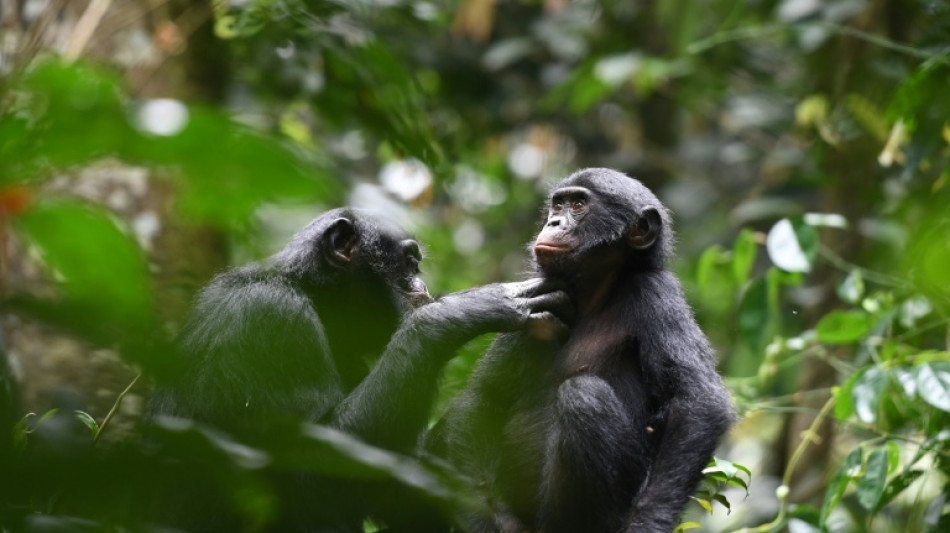
-
 New photo dump fuels Capitol Hill push on Epstein files release
New photo dump fuels Capitol Hill push on Epstein files release
-
Brazil, Mexico seek to defuse US-Venezuela crisis

-
 Assange files complaint against Nobel Foundation over Machado win
Assange files complaint against Nobel Foundation over Machado win
-
Private donors pledge $1 bn for CERN particle accelerator

-
 Russian court orders Austrian bank Raiffeisen to pay compensation
Russian court orders Austrian bank Raiffeisen to pay compensation
-
US, Qatar, Turkey, Egypt to hold Gaza talks in Miami

-
 Lula open to mediate between US, Venezuela to 'avoid armed conflict'
Lula open to mediate between US, Venezuela to 'avoid armed conflict'
-
Brussels farmer protest turns ugly as EU-Mercosur deal teeters

-
 US imposes sanctions on two more ICC judges for Israel probe
US imposes sanctions on two more ICC judges for Israel probe
-
US accuses S. Africa of harassing US officials working with Afrikaners

-
 ECB holds rates as Lagarde stresses heightened uncertainty
ECB holds rates as Lagarde stresses heightened uncertainty
-
Trump Media announces merger with fusion power company

-
 Stocks rise as US inflation cools, tech stocks bounce
Stocks rise as US inflation cools, tech stocks bounce
-
Zelensky presses EU to tap Russian assets at crunch summit

-
 Pope replaces New York's Cardinal Dolan with pro-migrant bishop
Pope replaces New York's Cardinal Dolan with pro-migrant bishop
-
Odermatt takes foggy downhill for 50th World Cup win

-
 France exonerates women convicted over abortions before legalisation
France exonerates women convicted over abortions before legalisation
-
UK teachers to tackle misogyny in classroom

-
 Historic Afghan cinema torn down for a mall
Historic Afghan cinema torn down for a mall
-
US consumer inflation cools unexpectedly in November

-
 Danish 'ghetto' residents upbeat after EU court ruling
Danish 'ghetto' residents upbeat after EU court ruling
-
ECB holds rates but debate swirls over future

-
 Pope replaces New York's Cardinal Timothy Dolan with little-known bishop
Pope replaces New York's Cardinal Timothy Dolan with little-known bishop
-
Bank of England cuts interest rate after UK inflation slides

-
 Have Iran's authorities given up on the mandatory hijab?
Have Iran's authorities given up on the mandatory hijab?
-
Spain to buy 100 military helicopters from Airbus

-
 US strike on alleged drug boat in Pacific kills four
US strike on alleged drug boat in Pacific kills four
-
Thailand strikes building in Cambodia's border casino hub

-
 Protests in Bangladesh as India cites security concerns
Protests in Bangladesh as India cites security concerns
-
European stocks rise before central bank decisions on rates

-
 Tractors clog Brussels in anger at EU-Mercosur trade deal
Tractors clog Brussels in anger at EU-Mercosur trade deal
-
Not enough evidence against Swedish PM murder suspect: prosecutor

-
 Nepal's ousted PM Oli re-elected as party leader
Nepal's ousted PM Oli re-elected as party leader
-
British energy giant BP extends shakeup with new CEO pick

-
 Pulitzer-winning combat reporter Peter Arnett dies at 91
Pulitzer-winning combat reporter Peter Arnett dies at 91
-
EU kicks off crunch summit on Russian asset plan for Ukraine

-
 Lyon humbled to surpass childhood hero McGrath's wicket tally
Lyon humbled to surpass childhood hero McGrath's wicket tally
-
Sri Lanka plans $1.6 bn in cyclone recovery spending in 2026

-
 England vow to keep 'fighting and scrapping' as Ashes slip away
England vow to keep 'fighting and scrapping' as Ashes slip away
-
'Never enough': Conway leans on McKenzie wisdom in epic 300 stand

-
 Most Asian markets track Wall St lower as AI fears mount
Most Asian markets track Wall St lower as AI fears mount
-
Cambodia says Thailand bombs casino hub on border

-
 Thai queen wins SEA Games gold in sailing
Thai queen wins SEA Games gold in sailing
-
England Ashes dreams on life-support as Australia rip through batting

-
 Masterful Conway, Latham in 323 opening stand as West Indies wilt
Masterful Conway, Latham in 323 opening stand as West Indies wilt
-
Danish 'ghetto' tenants hope for EU discrimination win

-
 Cricket Australia boss slams technology as Snicko confusion continues
Cricket Australia boss slams technology as Snicko confusion continues
-
Conway and Latham's 323-run opening stand batters hapless West Indies

-
 Alleged Bondi shooters holed up in hotel for most of Philippines visit
Alleged Bondi shooters holed up in hotel for most of Philippines visit
-
Japan govt sued over 'unconstitutional' climate inaction


Good neighbors: Bonobo study offers clues into early human alliances
Human society is founded on our ability to cooperate with others beyond our immediate family and social groups.
And according to a study published Thursday in the journal Science, we're not alone: bonobos team up with outsiders too, in everything from grooming to food sharing, even forming alliances against sexual aggressors.
Lead author Liran Samuni of the German Primate Center in Gottingen told AFP that studying the primates offered a "window into our past," possibly signaling an evolutionary basis for how our own species began wider-scale collaborative endeavors.
Bonobos (Pan paniscus) are our closest living relatives, alongside chimpanzees (Pan troglodytes), and the two species are also very closely related to each other.
But while encounters between chimpanzee groups are inherently hostile and often result in lethal violence, interactions between bonobo parties hadn't been as well examined.
That's because bonobos, an endangered species, are notoriously difficult to study in their natural habitat -- and they live only in remote regions of the Democratic Republic of the Congo.
With research on chimps dominating the literature, some scientists assumed hostility against outsiders was innate to human nature -- something we had perhaps trained ourselves to get past by inventing new social norms, even as that trait lurked deep inside.
- Female coalitions against sexual aggression -
In the new paper, Samuni teamed up with Martin Surbeck, a professor at Harvard who founded the Kokolopori Bonobo Reserve, to carry out a long-term study over two years.
"The first thing they do... is try to run away from you," Surbeck told AFP, explaining it took a long time for the bonobos to overcome their inherent fears of humans and behave normally.
Days began at 4:00 am and involved researchers trekking through the dark forest until they reached bonobo nests, then waiting for sunrise so they could follow the apes throughout the day, aided by indigenous Mongandu trackers.
Samuni and Surbeck focused on two small bonobo groups of 11 and 20 adults respectively, and found to their surprise they spent 20 percent of their total time together -- feeding, resting, traveling and more.
"Every individual is different," said Samuni. "There are those that are more introverts, extroverts, there are those that are more pro-social than others."
The team found that cooperation between the groups was driven largely by a select few who were more helpful within their own group. These individuals tended to connect with similar "pro-social" bonobos from the other group, creating a system of mutual benefit, or "reciprocal altruism."
The positive interactions occurred despite a low level of genetic relatedness between the groups, and despite the fact that reciprocity -- such as paying back a gift of fruit -- often took place much later, in future encounters.
Intriguingly, females, both within and from different groups, were found to form coalitions -- sometimes to chase an individual from a feeding tree, at other times to prevent a coercive sexual advance from a male.
"We don't see sexual coercion in bonobos, which is a common phenomenon in chimpanzees," said Surbeck. "One aspect of that might be due to those female coalitions, that help the females to maintain reproductive autonomy."
- Are we more like chimps or bonobos? -
The authors suggest their research offers an "alternative scenario" to the idea human cooperation is against our nature, or that we broadened cooperation with outsiders by first merging our extended families.
But "this does not mean that reconstructions of ancestral hominin species should be based only on bonobos," Joan Silk, a scientist at Arizona State University wrote in a related commentary.
There are other ways in which chimpanzees seem closer to humans than bonobos -- for example they more often hunt animal prey and use tools. Male chimpanzees also form strong bonds with fellow males and support them in aggressive acts, while bonobo males form stronger ties to females.
Understanding the natural selection forces that created these differences "may help to elucidate how and why humans became such an unusual ape," she concluded.
H.E.Young--AMWN



